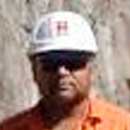
Faisal Sayeed, P.Geo., is a mineral rights specialist with the Government of Northwest Territories.
A rare find while hiking
Ihave worked in the mining and exploration industry for the past 16 years.
I graduated from the University of Saskatchewan in 2003 with dreams and aspirations of working in the oil and gas sector, but fate would have me go in a different direction when I got an offer from a large oilsands mining operation in Fort McMurray, Alta.
I was hooked!
It did not take long to realize how engaging the mining industry is and how exciting my career would be as I grew more comfortable in my various roles.
Every day is unique, brings new challenges and amazing opportunities to solve problems. I work with diverse, fun-loving and overtly optimistic colleagues (it is vital to be optimistic in the mining sector, especially in exploration).
I am currently engaged with the Government of Northwest Territories as a Mineral Rights Specialist, assisting in drafting new regulatory framework for mining and resource development.
How did I find my favourite rock?
On a recent hike in the bush around Yellowknife, I found a chunk of a very special igneous rock called pegmatite. Pegmatite is easy to spot due to its large crystals and its dull lustre due to abundance of quartz or feldspar.
My specimen, however, was a bit different with red and purple crystals and contained minerals I could not readily identify. Naturally, the rock went straight into my backpack for further questioning.
Later that week, the mystery mineral was identified by one of my esteemed colleagues as Bastnäsite. This was really exciting as I had never seen this mineral before. My new pegmatite specimen became very special.
Pegmatite(s) are very unique igneous rocks formed during the final stages of crystallization in magma chambers, deep below the earth crust.
Most intrusive igneous rocks (such as granites) have large crystals due to slow cooling of magma. But pegmatite(s) go through an extra step during that process, which not only makes them stand out from the rest, but also a potential source rock for Rare Earth Elements (REE); valuable commodity these days.
In the early stages of crystallization, magma usually contains large amounts of dissolved water. As the minerals with the highest melting point (most common rock forming material) start to crystallize, water is not removed.
As crystallization progresses, water becomes overabundant and eventually separates in magma, forming pockets of low viscosity regions in the melt. This allows lighter, smaller ions (such as lithium and beryllium) to move freely in the low viscosity environment compared to the rest of the magma.
As the gradual cooling of magma continues, larger crystals start to form containing elements not commonly found in most rocks; hence, the elevated contents of REE.